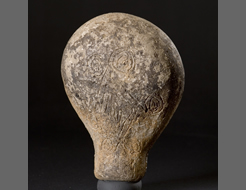|
||||||||||||||||||||||||||||||||
|
|
Museum of: Wien | |||||||||||||||||||||||||||||||
| Name of the artefact: Spoon with pictograph from Wetzleinsdorf | ||||||||||||||||||||||||||||||||
|
The combination of rhombus, spiral and meander
represents abstract spiritual contexts which seem to have been well
understood even outside the Lengyel area. with a view to similar finds the
ideogram seems to be a product of western Lengyel groups. From the
beginning of the 6th millennium similar characteristics concerning
pictograms on ceramics probably used in rituals can be detected in the
Stracevo-culture, the older phase of Linear Pottery Period, Precucuteni,
Cucuteni-Tripolje, Gumelnitsa, Theiß, younger phase of Vinca and typical
Lengyel. |
||||||||||||||||||||||||||||||||
|
WHERE IS IT AND MAIN
CHARACTERISTICS |
STATE |
|||||||||||||||||||||||||||||||
|
Department: |
Prehistory |
Preservation: |
Very good | |||||||||||||||||||||||||||||
|
Inventory number: |
92.282 |
Restauration: |
Restored | |||||||||||||||||||||||||||||
|
Name of the artefact: |
Spoon with pictograph from Wetzleinsdorf
|
Completeness: |
Complete | |||||||||||||||||||||||||||||
|
Object type: |
Tool |
|||||||||||||||||||||||||||||||
|
Material: |
Ceramic |
|||||||||||||||||||||||||||||||
|
Methof of manufacture: |
Burnt clay |
|||||||||||||||||||||||||||||||
|
Decoration
type: |
No decoration |
|||||||||||||||||||||||||||||||
|
Distinctive mark: |
- |
|||||||||||||||||||||||||||||||
|
DIMENSIONS |
PERIOD OF USE |
|||||||||||||||||||||||||||||||
|
Length (mm): |
- |
Epoque: |
Neolithic |
|||||||||||||||||||||||||||||
|
Heigth
(mm): |
- |
Culture: |
Painted Pottery |
|||||||||||||||||||||||||||||
|
Diameter
(mm): |
- |
Period: |
Middle neolithic |
|||||||||||||||||||||||||||||
|
Width (mm): |
- |
Face: |
MOG |
|||||||||||||||||||||||||||||
|
Thickness (mm): |
- |
Absolute chronology: |
4500 bc |
|||||||||||||||||||||||||||||
|
Weight
(g): |
- |
|||||||||||||||||||||||||||||||
DISCOVERY |
||||||||||||||||||||||||||||||||
|
Date: |
Between 1950 and 1990 |
Country: |
Austria |
|||||||||||||||||||||||||||||
|
District: |
Wolkersdorf |
Town hall affiliation: |
- |
|||||||||||||||||||||||||||||
|
Village: |
Wetzleinsdorf |
Discovery findspot: |
- |
|||||||||||||||||||||||||||||
|
Condition of discovery: |
Chance Discovery |
Discovery type: |
Deposit |
|||||||||||||||||||||||||||||
|
ANALYSES – DETERMINATIONS |
FILLED IN BY |
|||||||||||||||||||||||||||||||
|
Type: |
- |
Name: |
Walpurga Antl |
|||||||||||||||||||||||||||||
|
Laboratory: |
- |
Institution: |
Natural History Museum Vienna |
|||||||||||||||||||||||||||||
|
No./Code: |
- |
Date: |
20/02/2006 |
|||||||||||||||||||||||||||||
|
DEEPENINGS |
||||||||||||||||||||||||||||||||
|
Morphology of the object: |
||||||||||||||||||||||||||||||||
|
Ceramic spoon with socketed handle and decoration at
the back |
||||||||||||||||||||||||||||||||
|
Decoration: |
||||||||||||||||||||||||||||||||
|
Incised pictograph combining spiral, rhombus and
meander |
||||||||||||||||||||||||||||||||
|
Inscription: |
||||||||||||||||||||||||||||||||
|
- |
||||||||||||||||||||||||||||||||
|
Analogies: |
||||||||||||||||||||||||||||||||
|
The same pictograph is used on a Vessel from Strelice
together with stylized blessing or adoring human figures. With a view to
similar finds the ideogram seems to be a product of western Lengyel
groups. |
||||||||||||||||||||||||||||||||
|
Interpretation: |
||||||||||||||||||||||||||||||||
|
Sign which might have been commonly understood in a
bigger regional context. From the beginning of the 6th millennium similar
characteristics concerning pictograms on ceramics probably used in rituals
can be detected in the Stracevo-culture, the older phase of Linear Pottery
Period, Precucuteni, Cucuteni-Tripolje, Gumelnitsa, Theiß, younger phase
of Vinca and typical Lengyel. |
||||||||||||||||||||||||||||||||
|
Bibliography: |
||||||||||||||||||||||||||||||||
|
RUTTKAY,E. (1997: Ein Lengyel-Löffel mit ideogramm aus
Wetzleinsdorf, Niederösterreich. SPFFBU M2, 49-64 |
||||||||||||||||||||||||||||||||

